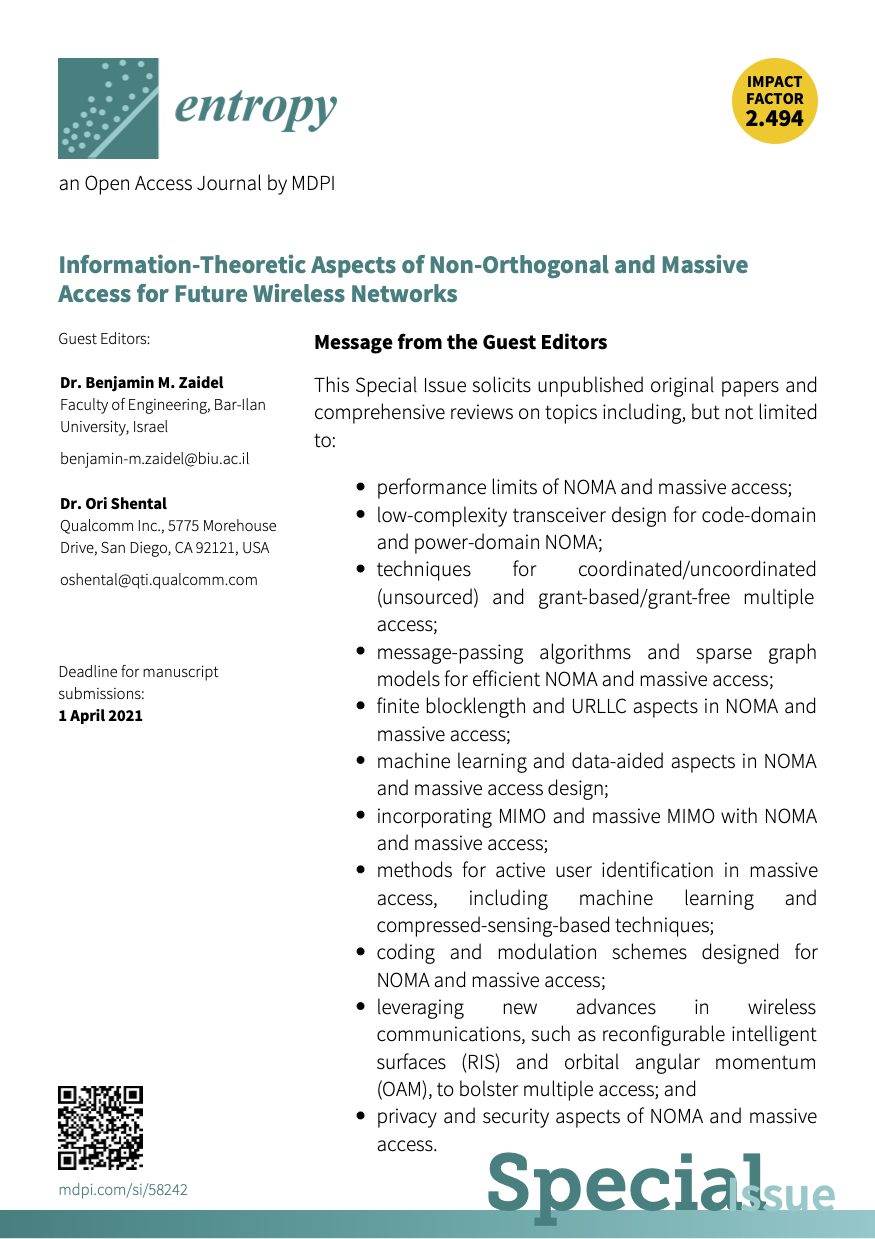
Dear Colleagues,
The vision for future wireless networks encompasses a wide variety of applications, featuring dramatically higher throughputs as well as massive machine-type communications. It manifests the evolution from human-centric communications, through the current epoch of “internet-of-things” (IoT), to the era of “internet-of-everything” (IoE) expected to evolve during the next decade. This motivates a paradigm shift from legacy orthogonal multiple access (OMA) to non-orthogonal multiple access (NOMA), where the number of simultaneously active users exceeds the number of available time–frequency–space resources. Information-theoretic analyses of NOMA schemes have been a fruitful ground for research in recent years; however, a full comprehension of the fundamental performance limits of the envisioned use-cases is still lacking. Obviously, classical Shannon-type approaches to deriving key performance measures, such as the achievable spectral efficiency, remain useful and of clear interest in certain settings. Nevertheless, some key features of massive machine-type communications may require new paradigms more suitable for the specific characteristics of such settings. In particular, the focus has seemed to shift to new scaling laws for the number of users, code blocklengths, and number of receiving antennas. Moreover, alternative performance measures, such as the recently introduced message-length capacity and per-user probability of error (PUPE), may be essential to a more insightful analytical foundation. In this framework, the notion of “massive access” has been recently considered as an alternative to the classical multiple-access channel setting. Essentially, the massive access model lets the number of active users scale with the blocklength and facilitates analysis of the impact of finite (and short) code blocklengths due to stringent delay constraints, user burstiness, and connectivity larger by orders of magnitude than in classical settings. This Special Issue aims to present a broad information-theoretic perspective of the state-of-the-art of non-orthogonal and massive access research and invites authors to present recent advances in the field that shed light on the challenges ahead in the design of future wireless networks.
This Special Issue solicits unpublished original papers and comprehensive reviews on topics including, but not limited to:
- performance limits of NOMA and massive access;
- low-complexity transceiver design for code-domain and power-domain NOMA;
- techniques for coordinated/uncoordinated (unsourced) and grant-based/grant-free multiple access;
- message-passing algorithms and sparse graph models for efficient NOMA and massive access;
- finite blocklength and URLLC aspects in NOMA and massive access;
- machine learning and data-aided aspects in NOMA and massive access design;
- incorporating MIMO and massive MIMO with NOMA and massive access;
- methods for active user identification in massive access, including machine learning and compressed-sensing-based techniques;
- coding and modulation schemes designed for NOMA and massive access;
- leveraging new advances in wireless communications, such as reconfigurable intelligent surfaces (RIS) and orbital angular momentum (OAM), to bolster multiple access; and
- privacy and security aspects of NOMA and massive access.
Important Dates:
Submission Deadline: April 1, 2021
Accepted papers are immediately published online.
Guest Editors:
Dr. Benjamin M. Zaidel (Bar-Ilan University)
Dr. Ori Shental (Qualcomm Inc.)
__________________________________
* Entropy is an open access journal which maintains a rigorous and fast peer-review system and accepted papers are immediately published online. Because it is an online and open access journal, papers published in Entropy will receive high publicity. It is fully covered by the leading indexing and abstracting services, including Google Scholar, MathSciNet, Scopus and Science Citation Index Expanded (Web of Science). The Impact Factor for Entropy is 2.494 (2019).
